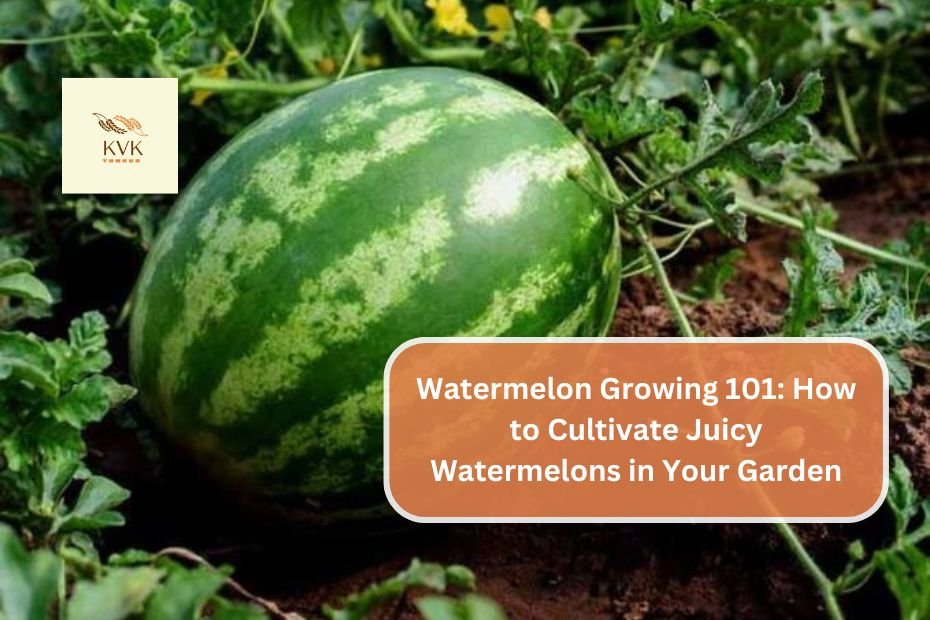Growing watermelons can be a rewarding experience, especially when you harvest sweet, juicy fruits during the hot summer months. Here’s a comprehensive guide on how to cultivate watermelons successfully, covering everything from site selection to harvesting.
1. Choosing the Right Variety
Select a watermelon variety that suits your climate and space. Common types include:
- Crimson Sweet: A large, red-fleshed variety known for its sweetness and disease resistance.
- Mickylee: An icebox type that is smaller, making it perfect for limited spaces.
- Yellow Baby: A smaller, yellow-fleshed variety that offers a unique flavor profile.
2. Site Selection
Watermelons thrive in warm, sunny locations:
- Sunlight: Choose a spot that receives at least 6 to 8 hours of direct sunlight daily.
- Soil Conditions: Watermelons prefer well-drained, sandy loam soils rich in organic matter. Avoid areas with heavy clay or poor drainage.
3. Soil Preparation
Preparing the soil properly is essential for healthy growth:
- Soil Testing: Conduct a soil test to determine pH (ideal range is 6.0 to 6.8) and nutrient levels.
- Amendments: Incorporate organic matter like compost or well-rotted manure into the top 6 inches of soil to enhance fertility and drainage.
4. Planting Watermelons
Timing and planting technique are crucial:
- When to Plant: Wait until soil temperatures reach at least 70°F (21°C), typically after the last frost date.
- Spacing: Plant seeds about 1-2 inches deep in mounds spaced 3 to 5 feet apart. If using transplants, space them about 2 feet apart in rows that are 4-6 feet apart.
- Thinning: After seedlings emerge, thin them to 2 plants per mound to ensure adequate space for growth.
5. Watering and Irrigation
Watermelons require consistent moisture, especially during fruit development:
- Irrigation Method: Use drip irrigation or soaker hoses to deliver water directly to the roots while minimizing leaf wetness, which can lead to fungal diseases.
- Watering Schedule: Water deeply but infrequently, aiming for about 1-2 inches per week, adjusting based on rainfall and soil moisture levels.
6. Fertilization
Watermelons are heavy feeders and require regular fertilization:
- Initial Fertilization: Before planting, mix a balanced fertilizer into the soil according to soil test recommendations.
- Side Dressing: Once vines develop runners, side dress with nitrogen-rich fertilizers (like a 21-0-0 formula) every few weeks to promote healthy growth.
7. Pest and Disease Management
Monitoring for pests and diseases is vital for a successful harvest:
- Common Pests: Watch for aphids, spider mites, and cucumber beetles. Use organic insecticides or introduce beneficial insects like ladybugs.
- Diseases: Prevent fungal diseases by ensuring good air circulation around plants and avoiding overhead watering. Remove any diseased foliage promptly.
8. Supporting Your Melons
As watermelons grow, they may need some support:
- Mulching: Use straw or cardboard under developing fruits to prevent rot and protect them from pests.
- Shade Protection: In extreme heat, consider providing shade for young melons to prevent sunscald.
9. Harvesting Watermelons
Knowing when to harvest is key to enjoying sweet fruit:
- Signs of Ripeness: Look for a dry tendril near the stem, a yellow ground spot where the melon touches the soil, and dull skin color.
- Harvesting Technique: Use sharp pruning shears to cut the fruit from the vine, leaving a short stem attached.
Conclusion
Cultivating watermelons requires attention to detail in terms of site selection, soil preparation, watering practices, pest management, and harvesting techniques. By following these guidelines, you can enjoy a bountiful harvest of sweet, juicy watermelons that are perfect for summer picnics and gatherings! Happy gardening!
| HOME | CLICK HERE |
| CATEGORY | CLICK HERE |

